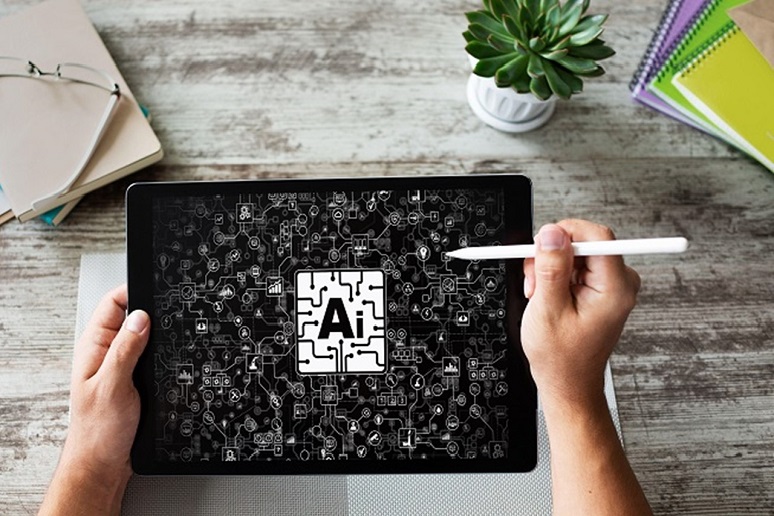Where We Stand With AI
AI has already begun to make impacts both large and small on the workplace. One of the biggest, yet more subtle, uses of AI in the office comes by way of collaboration and communications tools. Both before and during the pandemic, technology companies like Microsoft, Zoom, Cisco, and others added a host of AI-based features to their meeting and collaboration products and services. Now, it’s hard to find a video meeting service that doesn’t offer features like background noise suppression, transcription capabilities, and background filters and blurs – largely built on AI technology.
Beyond communications and collaboration, AI can be found elsewhere in the workplace. In HR, AI is improving overall operations and the talent recruiting process. In a recent survey of over 1,600 HR professionals, the Society for Human Resource Management
(SHRM) found that 53% of respondents felt AI and automation somewhat improved filling open positions, and another 16% said AI led to "much better" results in filling these jobs.
HR and IT aren’t the only departments seeing the benefits of AI, as facilities management professionals are also relying on the technology more. One area where facilities management can use AI is to reduce the energy consumption related to cooling spaces. In its Annual Energy Outlook 2022,
the U.S. Energy Information Administration found that the commercial sector used about 153 billion kWh for cooling in 2021, equaling about 12% of the total electricity consumed by the sector.
To address this and boost sustainability, Brainbox AI offers an AI-based HVAC system that can learn the thermal behaviors of a space, be fed external information like weather forecasts and utility tariffs, and then send commands to individual pieces of HVAC equipment, as described on
Brainbox AI's website. As sustainability efforts increase across the globe to combat climate change, products and services like these should see more adoption.
Where We Might Be Heading
While a certain amount of “AI washing” is widespread across the technology industry (i.e., not everything that’s labeled AI is actually AI), the promise of AI – its ability to make future predictions –should perk up the ears of anyone involved in workplace planning. We are seeing many benefits of AI today, but in many ways, it’s just the tip of the iceberg.
Take for instance, the issue of space optimization. In a
recent article, Eric Krapf, publisher of WorkSpace Connect and GM and program co-chair for Enterprise Connect, shared how commercial real estate company JLL was attempting to reinvent the space reallocation process with its Dynamic Occupancy Management system, which combines space booking, reservation systems, utilization tracking, and a layer of AI "to figure out where people should go in the building." With the Dynamic Occupancy Management system, workplace leaders can access space data and analytics in real-time and speed up the process of reallocations from the typical three-to-five years to a quarterly basis.
This data can certainly help make smarter workspace decisions, but I can see this technology going a step further. For instance, what if AI could tell you precisely when you will see a surge of COVID or another infectious disease in an area, months before it happens? With this information, workplace leaders can retool their HR policies and workplace strategies to meet the challenge before it even materializes.
Take another example related to real estate strategy. Over the last year or two, many workplaces have experimented with their first-draft version of hybrid work and returning to the office. Using data like how many employees have returned to the office, the offices they reported to, and with what frequency, AI can predict how many employees will be working in the office next week, next month, next year, etc. With this information, workplaces can then downsize their real estate holdings or open new spaces to meet demands for the current moment and the future.
Though workplaces might be years away from fully implementing AI in these ways, we are already seeing AI move the needle in the workplace. Though the use of AI will likely increase, workplace leaders need to be vigilant that AI’s misuse doesn’t increase as well. The problem of having bad training data has been
a well-documented critique/issue of AI, and when AI is hastily deployed and not given the proper context, it can lead to bias.
At this point in the AI discussion, the conversation often veers toward the idea that AI bots will simply take over a la
Skynet from Terminator. But as long as workplace leaders take the time to understand what AI can and can’t do — and what context you need to bring into those AI-generated results — I don’t think they need to worry. HR will always need to provide an empathetic/human touch in addressing serious concerns of employers. And until we develop sophisticated autonomous AI-based robots that can reconfigure the office space on the fly, I don’t think facility managers are going anywhere. The most tech-entrenched department, IT, will also need to lead with their expertise and insight on how to use AI properly, and ideally, they can be an added buffer in preventing ethical AI dilemmas from happening.
I might be a bit tongue-in-cheek about the idea of AI taking over, but AI is more clearly present in today’s office than ever before. Over on our sister site No Jitter, we often discuss
human-centered AI in the realm of contact center operations and customer experience, and I think the same can be applied to workplace planning and strategy. AI without humans will lead to workplace blunders — but by blending the two — it might just propel workplaces into the future of work.




